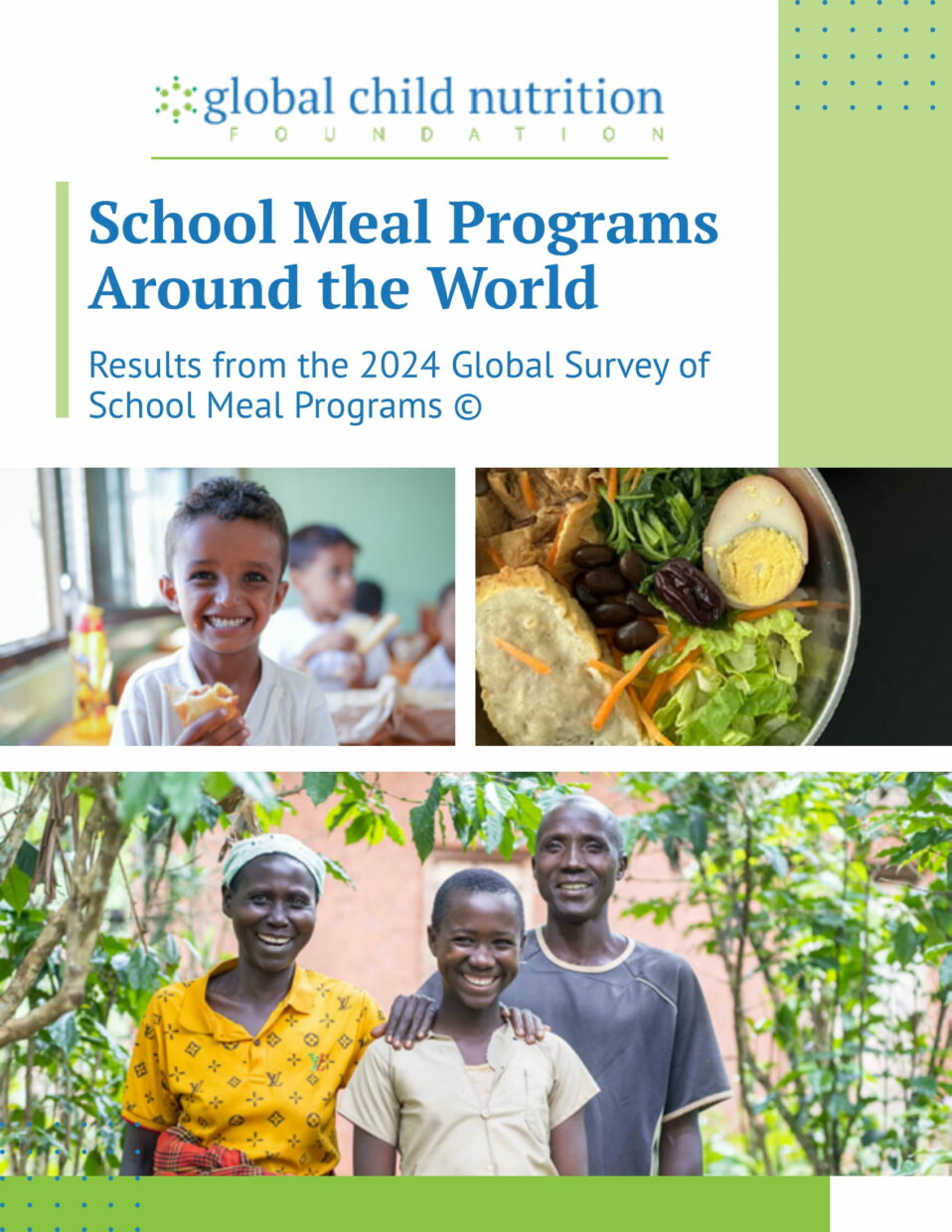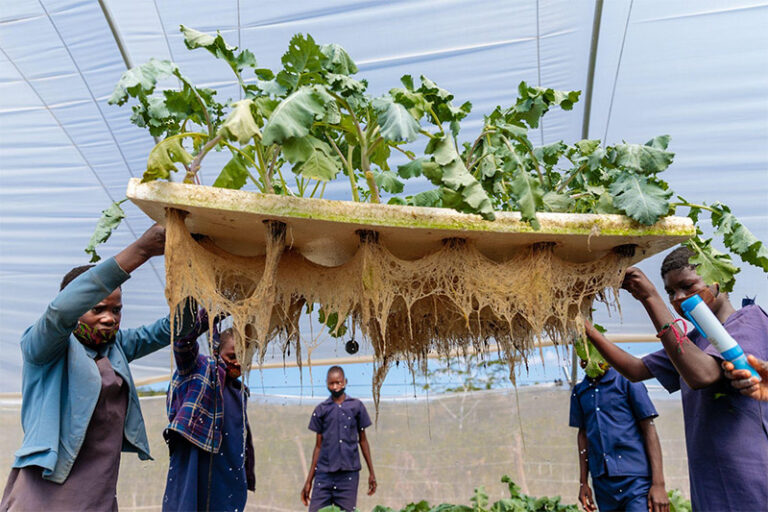
Press Release:
Solving Global Hunger: New Report Highlights School Meal Programs as Drivers of Change
New report explores powerful links between children’s nutrition, small-scale farmers, and global food system resilience
February 4, 2025 (Washington, D.C.) –School meal programs don’t just ensure children go to school and stay fed — they are a powerful force for change in communities and food systems worldwide. According to the results of the latest Global Survey of School Meal Programs© conducted by Global Child Nutrition Foundation (GCNF), school meal programs can increase demand for nutritious foods, support local farmers and influence the environmental sustainability of food systems. This report offers a unique lens to explore the scale, impact and potential of school meal programs, drawing on data from over 160 countries.
Impactful Reach
School meal programs served more than 407 million children in 2022, with one in four primary and secondary school-aged children receiving meals globally. The percentage of enrolled primary school students receiving food at school, which has been proposed as a new U.N. Sustainable Development Goal indicator, is even higher at 39%, or nearly 4 in 10. And, it’s on the rise.
“Access to school food helps address global food insecurity and malnutrition by providing millions of children access to nutritious diets, enhancing micronutrient sufficiency and shifting food preferences in a healthy direction,” says Arlene Mitchell, executive director of GCNF.
Children in Latin America and the Caribbean have better access to school feeding programs than any other region in the world, with just over half (51%) having access, according to the global report. Europe, Central Asia and North America come in second at 42%. From there, it drops steeply to 22% for South Asia, East Asia and the Pacific; 21% in the Middle East and North Africa and 19% for sub-Saharan Africa.
Nutrition and Equity
School meal programs in upper middle and high-income countries provide children better access to healthy foods like dairy products (96%) and fruits (94%) than those in low- and lower middle-income countries. However, they also are more exposed to unhealthy options like processed meats and deep-fried foods. In contrast, school meal programs in low-income countries rely more on legumes (83%) and liquid oils (89%).
Many programs maintain an explicit focus on creating jobs for categories of people who face barriers to accessing the labor market. Specifically, 44% of programs reported a focus on creating jobs for women and 25% reported a focus on creating jobs for youths. This was much more common among programs operating in low-income countries, with 67% giving attention to women’s employment and 40% giving attention to youth employment.
A Lifeline for Small-Scale Farmers
While school meal programs help address malnutrition for millions of children, they also support robust and equitable livelihoods by providing income-generating opportunities for local farmers and others in the food value chain. Plus, they employ a large labor force of school cooks and caterers, food handlers and others. More than half (57%) of the programs explicitly aim to provide small-scale farmers with access to the predictable and stable school food market and to maximize their benefits from such access. This figure rises to 80% among programs in low-income countries and 74% in lower middle-income countries. Yet, gaps remain — only 43% of programs offer additional support to smallholder farmers, revealing a critical opportunity for greater impact.
“The impact of school meal programs globally goes well beyond being an important source of nutritious food for millions of children,” says Mitchell. “By creating a large demand for safe, nutritious and sustainably produced food, school meals can drive global food systems transformation.”
Supporting Sustainable Food Systems
School meal programs can use their buying power to influence the environmental sustainability of food systems by developing environmentally friendly menus; 38% of programs targeted foods considered to be “climate-friendly,” and 79% took steps to reduce food miles.
Beyond sourcing from smallholders, Home-Grown School Feeding programs often include support extended to these farmers to strengthen their collective ability to serve as suppliers. In total, 43% of programs offered additional support to small-scale farmers, such as agricultural extension or training to supply school meal programs. This was most common in low-income countries (67%). Sub-Saharan Africa led on a regional basis, with 60% of programs there reporting they extended such support. Linking school gardens to meal programs can cultivate healthy food preferences; 84% of programs in low- and lower middle-income countries reported having gardens.
The 2024 Global Survey of School Meal Programs report was released at a hybrid policy seminar in Washington, D.C., co-hosted by GCNF and the International Food Policy Research Institute (IFPRI). The survey was conducted by GCNF with support from The Rockefeller Foundation and the U.S. Department of Agriculture. GCNF captured data from 167 countries via the three Global Surveys that have so far been conducted, covering the 2017, 2020 and 2022 school years.
“As this survey demonstrates, school feeding programs can help reshape markets and shift mindsets towards home-grown, climate-resilient meals that nourish students,” said Roy Steiner, senior vice president of the Food Initiative at The Rockefeller Foundation. “The Rockefeller Foundation is dedicated to helping countries transform their school meal programs so they reach more learners, support local farmers and increase demand for regenerative agriculture.”
Visit GCNF’s website for a full copy of the School Meal Programs Around the World Report: Results from the 2024 Global Survey of School Meal Programs © and other resources.
###
Global Child Nutrition Foundation is a US-based 501(c)3 organization founded in 2006 that envisions a future where school meals sustainably nourish all children and help them, their families, communities, and nations to thrive. We provide governments and their partners with knowledge, tools, and connections so all children can access high-quality school meal programs that contribute to national educational, agricultural, economic, social protection, health and nutrition goals. Sign up for GCNF’s newsletter here, and follow us on LinkedIn @global-child-nutrition-foundation and on X @GCNFoundation.
The Rockefeller Foundation is a pioneering philanthropy built on collaborative partnerships at the frontiers of science, technology, and innovation that enable individuals, families, and communities to flourish. We make big bets to promote the well-being of humanity. Today, we are focused on advancing human opportunity and reversing the climate crisis by transforming systems in food, health, energy, and finance. For more information, sign up for our newsletter at www.rockefellerfoundation.org/subscribe and follow us on X @RockefellerFdn and LinkedIn @the-rockefeller-foundation.
Contact:
Daren Williams
Senior Vice President, Public Relations, Curious Plot
303-241-2419
Emily Fredenberg
Senior Program Officer, Global Child Nutrition Foundation
The data are made freely available for government decision makers, donors, researchers, and others dedicated to making data-informed decisions about school meal programs. The data have been rapidly incorporated into major global reports such as GCNF’s School Meal Programs Around the World, World Food Programme’s State of School Feeding Worldwide, and UNESCO’s Ready to Learn and Thrive report, and this data set is a key part of the monitoring mechanism for the School Meals Coalition.













No comment yet, add your voice below!